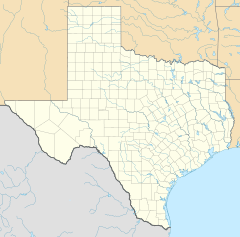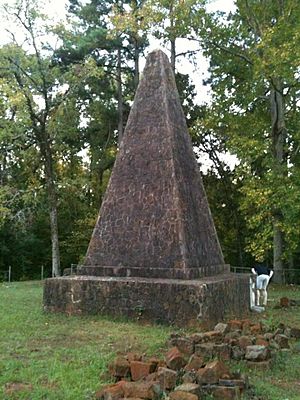Killough massacre facts for kids
Quick facts for kids Killough Massacre |
|
|---|---|
| Location | Larissa, Cherokee County, Texas |
| Coordinates | 32°3′17.18″N 95°20′35.33″W / 32.0547722°N 95.3431472°W |
| Date | October 5, 1838 (UTC-6) |
| Attack type | Raid on a frontier settlement |
| Deaths | 18 either killed or carried away |
| Perpetrator(s) | Cherokee |
The Killough event was a violent attack on settlers in East Texas. It is thought to be the largest and last attack of its kind by Native Americans in that area. The event happened on October 5, 1838. It took place near Larissa, Texas, in the northwestern part of Cherokee County. Eighteen people were affected, including Isaac Killough, Sr., and his large family. This included the families of his four sons and two daughters. They had moved to the Republic of Texas from Talladega County, Alabama, in 1837.
| Top - 0-9 A B C D E F G H I J K L M N O P Q R S T U V W X Y Z |
Why the Attack Happened
The Killough family and other settlers started clearing land for farms and building homes. They did not know that the Cherokee Indians living there strongly disagreed about who owned the land. Just one year before, this area had been set aside for the Cherokee. This was part of a treaty signed by Sam Houston and John Forbes.
However, the government of the Republic of Texas did not approve this treaty. In December 1838, they officially cancelled it. The Cherokee people were already upset, feeling they had given up enough land. This decision made them even angrier.
Growing Tensions
More and more Anglo settlers moved into lands the Cherokee believed were theirs. This made the Cherokee's anger grow. Some Hispanic people in the area were also still loyal to Mexico. This added to the tense feeling in early 1838. By that summer, there were rumors of possible rebellions from either group. There was also evidence that they might be secretly working together.
Fearing this growing unrest, the Killough family and their friends left their homes. They went to Nacogdoches to find safety. Cherokee leaders agreed to let them return safely to harvest their crops. But they had to promise to leave the area afterwards. The settlers did return to gather their crops.
The Attack Unfolds
On October 5, 1838, a group of Cherokee attacked the settlement. This group had not been part of the agreement. Most of the Killough group, a total of eighteen people, were either killed or taken away. This happened while they were working in their fields. Those who survived escaped to Lacy's Fort. This fort was on the San Antonio Road. It was just west of what is now Alto, Texas.
A newspaper writer named Charles Kilpatrick described what happened. Several men walked into a surprise attack. The Native Americans then shot Isaac, Jr., Allen, Samuel, and George Wood. They then moved into the settlement. Isaac, Sr., was killed in his front yard. Barakias Williams was killed in front of the women.
Eight settlers, including seven women and children, were captured. They were taken into the forest and were never seen again. Nathaniel Killough and his wife, with their 11-month-old baby girl, Eliza Jane, hid in a thick cane patch. Mrs. Samuel Killough, Mrs. Isaac Killough, Sr., Mrs. Isaac Killough, Jr., and the baby William also managed to escape. Three difficult days later, this small group reached Fort Lacy in Alto, about 40 miles south, where they found safety.
Remembering the Event
A tall stone monument was built to remember this event. The Works Progress Administration built it in the 1930s. A historical marker was also put up in 1965.



